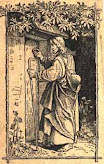Eucharistic Miracle of Trani, Italy (sec. XI) Italy (1000)

 A non-Christian woman, incredulous about the true Catholic dogma of the Real Presence of Jesus in the Eucharist, aided by some of her Christian friends, managed to steal a consecrated Host during the celebration of a Sacred Mass.
A non-Christian woman, incredulous about the true Catholic dogma of the Real Presence of Jesus in the Eucharist, aided by some of her Christian friends, managed to steal a consecrated Host during the celebration of a Sacred Mass. The w
 oman, a
oman, a s if daring God, put the consecrated Host into a frying pan of oil. Suddenly the Host spilled out masses of blood, which poured to the floor and out of the door of the house.
s if daring God, put the consecrated Host into a frying pan of oil. Suddenly the Host spilled out masses of blood, which poured to the floor and out of the door of the house.To this day in Trani, Puglia, the relic of this miracle, which happend around the year one thousand, is housed in the Cathedral of Holy Mary of the Assumption. There are numerous documents, which retell this miracle; among them are Eucharistic monograms, which are on the ancient streets of the city. Brother Bartolomeo Campi, describes in his work, “L'Inamorato di Gesù Cristo” (1625), an accurate account of the unfolding of the facts:
“Pretending to be Christian, the woman received Communion with the others… and took the consecrated Host from her mouth and transferred It to a handkerchief. Once home she wanted to experiment with whether or not It was bread and put the consecrate d Host into a heated frying pan filled with oil. Upon contact with the boiling oil, the consecrated Host miraculously became bloody Flesh, and a hemorrhage, so to speak, would not stop flowing and went from the pan all over the cursed woman and her house. Terrorized, the woman began to scream …and the neighbors ran over to find out the reasons behind her cries.
d Host into a heated frying pan filled with oil. Upon contact with the boiling oil, the consecrated Host miraculously became bloody Flesh, and a hemorrhage, so to speak, would not stop flowing and went from the pan all over the cursed woman and her house. Terrorized, the woman began to scream …and the neighbors ran over to find out the reasons behind her cries.
 d Host into a heated frying pan filled with oil. Upon contact with the boiling oil, the consecrated Host miraculously became bloody Flesh, and a hemorrhage, so to speak, would not stop flowing and went from the pan all over the cursed woman and her house. Terrorized, the woman began to scream …and the neighbors ran over to find out the reasons behind her cries.
d Host into a heated frying pan filled with oil. Upon contact with the boiling oil, the consecrated Host miraculously became bloody Flesh, and a hemorrhage, so to speak, would not stop flowing and went from the pan all over the cursed woman and her house. Terrorized, the woman began to scream …and the neighbors ran over to find out the reasons behind her cries. The archbishop was immediately informed of the events and ordered the return of the consecrated Host to the church. That same Cistercian Abbot Ferdidando Ughelli (1670), in his well-known encyclopedic work “Italia Sacra”, wrote in a notation of his seventh volume: “In Trani a sacred Host was fried to the dismay of our Faith… the true Flesh and Blood of Christ was unveiled in the unleavened bread which fell to the ground”. An indirect confirmation to this miracle is also found in the affirmation of St. Pio from Pietreclina, which exclaimed: “Trani is lucky to have been bathed by the Blood of Christ twice”. The first reference being to this miracle and the later to the miracle of the Colonna Crucifix from which an abundant stream of blood flowed from Jesus' nose. Thanks to the generosity of the nobleman Ottavian Campitelli, the house of the woman was converted into a chapel in 1706. In 1616 the relic of the Host was transferred to an antique silver shrine donated by Fabrizio de Cunio. Throughout various eras, many tests were performed on this sacred relic and verified, the last one took place in 1924, at the Inter-diocesan Eucharistic Congress headed by Monsignor Giuseppe Maria Leo.


















